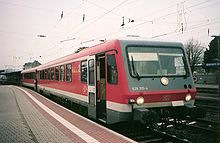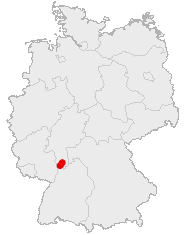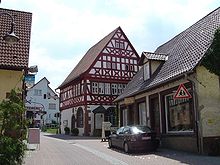Weinheim – Fürth railway line
| Weinheim (Bergstr) central station – Fürth (Odenw) | |||||||||||||||||||||||||||||||||||||||||||||||||||||||||||||||||||||||||||||||||||||||||||||||||||||||||||||
|---|---|---|---|---|---|---|---|---|---|---|---|---|---|---|---|---|---|---|---|---|---|---|---|---|---|---|---|---|---|---|---|---|---|---|---|---|---|---|---|---|---|---|---|---|---|---|---|---|---|---|---|---|---|---|---|---|---|---|---|---|---|---|---|---|---|---|---|---|---|---|---|---|---|---|---|---|---|---|---|---|---|---|---|---|---|---|---|---|---|---|---|---|---|---|---|---|---|---|---|---|---|---|---|---|---|---|---|---|---|
| Route number : | 4104 | ||||||||||||||||||||||||||||||||||||||||||||||||||||||||||||||||||||||||||||||||||||||||||||||||||||||||||||
| Course book section (DB) : | 654 | ||||||||||||||||||||||||||||||||||||||||||||||||||||||||||||||||||||||||||||||||||||||||||||||||||||||||||||
| Route length: | 16.521 km | ||||||||||||||||||||||||||||||||||||||||||||||||||||||||||||||||||||||||||||||||||||||||||||||||||||||||||||
| Gauge : | 1435 mm ( standard gauge ) | ||||||||||||||||||||||||||||||||||||||||||||||||||||||||||||||||||||||||||||||||||||||||||||||||||||||||||||
| Route class : | D4 | ||||||||||||||||||||||||||||||||||||||||||||||||||||||||||||||||||||||||||||||||||||||||||||||||||||||||||||
| Maximum slope : | <30 ‰ | ||||||||||||||||||||||||||||||||||||||||||||||||||||||||||||||||||||||||||||||||||||||||||||||||||||||||||||
|
|||||||||||||||||||||||||||||||||||||||||||||||||||||||||||||||||||||||||||||||||||||||||||||||||||||||||||||
The Weinheim – Fürth railway line , also known as the Weschnitz Valley Railway , is a branch line in Baden-Württemberg and Hesse . It branches off the Frankfurt – Heidelberg railway line in Weinheim an der Bergstrasse and leads in the Weschnitz valley to Fürth in the Odenwald .
history
After the Main-Neckar-Bahn was built along the Bergstrasse in 1846, it became necessary to connect the front Odenwald to the railway network. In the years after 1860 different routes were discussed. One of the goals was to run a route from Worms via Bensheim or Heppenheim into the Odenwald. In 1869, Bensheim was connected to the Riedbahn to Worms by the Nibelungen Railway via Bürstadt and Lorsch .
At the same time, plans were made for a north-south railway through the Odenwald, which was implemented as the Odenwaldbahn by 1882 .
Because of the difficult mountainous terrain on the edge of the Odenwald, the desired west-east connection into the Odenwald was led after long discussions through the relatively flat Weschnitz Valley from Weinheim.
construction
The railway line was built by the Grand Ducal Hessian State Railways . The surveying work began in 1890, the construction work in 1893. Between Weinheim and Birkenau three tunnels and two larger bridges had to be built in a very narrow section of the valley . On July 1, 1895, operations between Weinheim and Fürth began, initially on the condominium- operated Main-Neckar Railway , to whose main line the Weschnitz Valley Railway was connected. The originally planned continuation via Erbach to Wertheim to link the three north-south routes Main-Neckar-Bahn, Odenwaldbahn and Miltenberg West-Wertheim was abandoned.
Further development
After the Main-Neckar-Bahn was taken over by the Prussian-Hessian Railway Community in 1902, the line belonged to the district of the Mainz railway, later Reichsbahndirektion . On February 10, 1914, new “double light pre-signals ” were put into operation on the route “ when it got dark” , which corresponded to the shape signal model that is still in use today . On February 25, 1916, a new district telegraph line (No. 62) went into operation along the route .
Networking
- There was also great interest in the connection of Wald-Michelbach and Wahlen to the railway network in Überwald to the east . In 1897 construction began on the Überwaldbahn , which was shut down in 1994.
- Since a route from Worms via Heppenheim into the Odenwald was not built, but a direct connection from the Odenwald to Worms was desired, the Weinheim – Viernheim – Lampertheim – Worms line was built and opened in 1905.
- A 1902 intensively discussed extension should Fuerth in Odenwald Reichelsheim lead and connection to from there to Reinheim leading Gersprenz Talbahn produce. This gap of only about 9 km was not able to be closed because a sustainable financing could not be found.
business

A regional train runs every half hour, on weekends or every hour during off-peak hours. The travel time between Fürth and Weinheim is exactly 30 minutes, in the opposite direction only 26 minutes. The meetings take place every hour at the usual symmetry minute shortly before the full hour in Birkenau, at half-hourly there also shortly before half an hour and additionally, a quarter of an hour's drive away, in Rimbach.
The route is now operated by Deutsche Bahn AG as line RB 69 and has the route book number 654. The route is entirely within the Rhein-Neckar transport association (VRN) and there is a transitional tariff to the Rhein-Main transport association (RMV).
The platforms of all train stations and stops are marked with u. a. provided with guide strips for the blind .
The train conductor has been in the electronic signal box (ESTW) in Wiebelsbach since December 17, 2010 and no longer in the signal box in Weinheim (Bergstr). Lorsch was also planned as a train conductor signal box, but was rejected again.
Coradia LINT multiple units have been operating there since December 2015 , replacing the 628 multiple units that have been in service since 1993 .
literature
- Hans-Günther Morr: With full steam through the Odenwald: The history of the Weschnitz Valley and Überwald Railway through the ages . Edition Diesbach, Weinheim 2002, ISBN 3-936468-11-7
- Joachim Gutjahr: Weinheim - Fürth saved . In: Eisenbahn-Kurier , 8, No. 215, 1990, ISSN 0170-5288 , pp. 24-26.
Web links
- Tunnel portals of the Weschnitz Valley Railway
- Photographs of the Überwald and Weschnitz Valley Railway
- Pictures of the Weschnitz Valley Railway Weinheim-Fürth in April 1985 by Jörg Klawitter
Individual evidence
- ↑ DB Netze - Infrastructure Register
- ↑ Railway Atlas Germany . 9th edition. Schweers + Wall, Aachen 2014, ISBN 978-3-89494-145-1 .
- ↑ Sven Grahner, Andreas Müller: 111 years Weschnitz Valley Railway. Review and outlook on the future of the Odenwald route. (No longer available online.) In: PRO BAHN Regionalverband Rhein-Neckar. PRO BAHN Baden-Württemberg e. V., August 31, 2006, archived from the original on July 14, 2013 ; Retrieved September 8, 2013 . Info: The archive link was inserted automatically and has not yet been checked. Please check the original and archive link according to the instructions and then remove this notice.
- ↑ See: Eisenbahndirektion Mainz (Ed.): Collection of the published official gazettes of March 2, 1901. Volume 5, No. 9, Announcement No. 81, p. 51.
- ↑ Eisenbahndirektion Mainz (ed.): Official Journal of the Royal Prussian and Grand Ducal Hessian Railway Directorate in Mainz of January 24, 1914, No. 5. Announcement No. 50, p. 33.
- ^ Eisenbahndirektion Mainz (ed.): Official Gazette of the Royal Prussian and Grand Ducal Hessian Railway Directorate in Mainz of March 4, 1916, No. 11. Announcement No. 138, p. 74.
- ^ Walter Kuhl: Fragments on the edge of the Riedbahn from Darmstadt to Goddelau. Two tracks that never came about through the Odenwald around Lindenfels - documentation .



